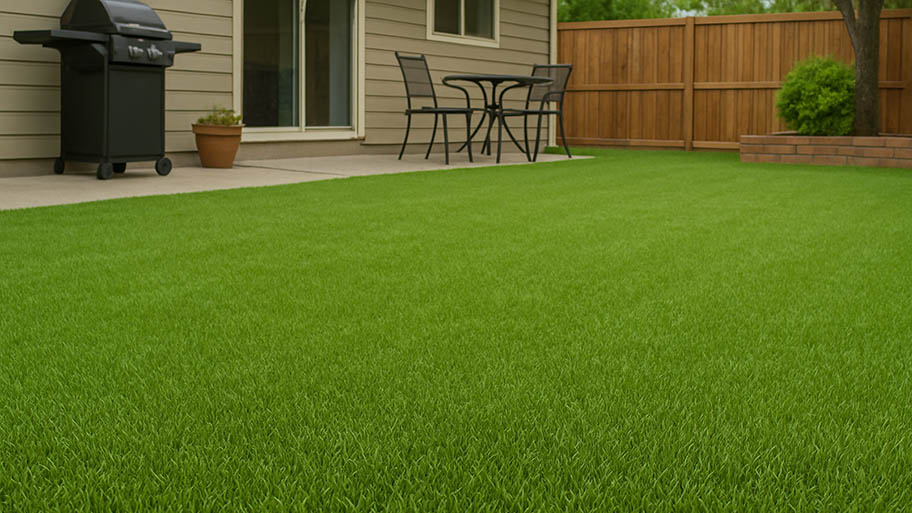
Your total lawn care cost depends on several factors, including the type of service and lawn size. Our guide will cover what you can expect to pay for lawn care.
Achieve lawn stripes worthy of the big leagues


Whether you’re a sports fan or not, there’s no denying the appeal of learning how to stripe a lawn with stadium-worthy cuts. Luckily, the look isn’t out of the average homeowner’s league: With a lawn mower and the right technique, you can achieve stripes on your grass, too. If you’re feeling creative, you can go beyond basic lawn-mowing methods and make your lawn the talk of the neighborhood. Here’s how to stripe a lawn like a pro.
A blade of grass has two sides: One light and one dark. Creating the illusion of lawn stripes involves cutting the blades and tilting them to either side to showcase these lights and darks. By bending each row of blades in alternating directions, you’re allowing sunlight to reflect off the rows facing away from you, making them appear lighter and creating stripes of lighter and darker tones.

Before you begin, give your lawn a once-over and remove any objects that could get in the way of your mower, such as toys, garden tools, and doggie droppings. Once everything is clear and ready, here’s how to achieve a variety of designs with your lawn mower.
Creating a striped pattern in your lawn involves mowing straight lines in alternating directions. Here’s how to achieve it:
For the straightest lawn striping, find a straight driveway or path to reference and mow the first stripe parallel to it.
Start at one end of your lawn and mow in a straight line to the other side.
When you get to the end of that stripe, make a tight turn with your mower.
Mow the next row in the opposite direction.
To create a diagonal or diamond pattern, here’s what to do:
Start by mowing a strip around the perimeter of your lawn.
Next, mow a series of straight rows in alternating directions.
Mow a second set of rows that are diagonal to the first, continuing to alternate the direction of each line.
For checkerboard or criss-cross stripes, here’s what to do:
Follow the instructions for making a full set of straight lawn stripes.
Once the straight rows are complete, lift the mower deck and mow a second set of stripes that intersect with the first row at a 90-degree angle.
Finish by mowing a strip around the perimeter of the yard.
Circles are trickier to perfect, so consider mastering straight stripes before trying a circular stripe pattern. Here’s how to mow circles into your lawn:
Mow twice around the perimeter of your lawn.
Turn off the mower and move it to the center of where you want to start your first circle.
Turn on the mower and make the first circle, keeping it as small and tight as possible.
Mow the next circle in the opposite direction, slightly overlapping it with the first circle.
Continue making circles around your lawn.
When you are done making circles, mow a final strip around the edge of the lawn.

Follow these tips and tricks for perfecting the art of lawn striping.
Mow at a higher setting to achieve longer, softer, and more bendable blades of grass.
Ensure your mower blades are sharp to ensure a quick, clean cut.
Rather than looking straight down, look straight ahead 10 to 15 feet to help your lines stay straight.
To make stripes more pronounced, use a roller and roll the grass in the same direction you mowed.
If you don’t have a roller, try lowering your lawn mower blade by ¼ inch and making a second pass.
If your turn marks are noticeable, finish by mowing a final strip around the edges of the yard to cover them up.
If you live in a transitional climate zone, opt for a cool-season grass over a warm-season grass, as these typically have more flexible blades that will hold the striped pattern better.
Learning how to stripe a lawn is pretty straightforward, but the execution can get tricky. If you’re having trouble keeping your lines straight, achieving your desired design, or keeping up with your mowing in general, consider enlisting the help of a pro. A local lawn care service can help you achieve flawless stripes on your lawn and keep it healthy and thriving.
From average costs to expert advice, get all the answers you need to get your job done.

Your total lawn care cost depends on several factors, including the type of service and lawn size. Our guide will cover what you can expect to pay for lawn care.

The cost to renovate your lawn depends on the extent of the damage. Our guide will show you how much lawn renovation costs.

Artificial grass is a low-maintenance alternative to traditional turf. Learn how much artificial grass installation costs and what affects your price.

Does mowing less sound appealing? Here are the no mow grass pros and cons and alternative choices for a lawn that requires less maintenance.
Fertilizer burns can result in discolored or dead grass. These nine tips will help prevent lawn burn and keep your yard looking healthy and green with fertilizer.

What is carpet grass? Read on to learn more about this hardy and versatile grass type, including its uses, drawbacks, and care tips.